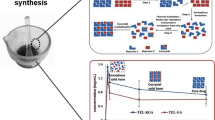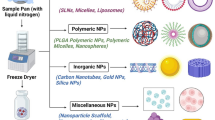Abstract
Nimesulide is a non-steroidal anti-inflammatory drug with a potent analgesic activity, but because it is practically insoluble in water, its bioavailability is significantly limited. One of the possible approaches for increasing the solubility and dissolution rate of a drug is to convert it from the crystalline to the amorphous form. Unfortunately, amorphous forms are generally unstable and do not guarantee an appropriate shelf life for the drug product. An interesting possibility for countering this difficulty is to use amorphous polymers to disperse the crystalline drug into the amorphous matrix, thus forming stable amorphous drug dispersions. In the present study, the thermal behavior of nimesulide and its physical stability in the amorphous state were fully characterized, and then, the possibility of prolonging its stability in the amorphous state was evaluated by dispersing the drug into two different amorphous polymers: poly(vinylpyrrolidone) or sodium alginate. The drug–polymer dispersion was obtained by co-heating the mix in a differential scanning calorimetry apparatus. The physicochemical stability of the pure nimesulide and the binary systems was evaluated by the Kolhaush–William–Watts equation. Aging experiments were carried out at different temperatures, and for each one the mean relaxation time constant was calculated to predict the physical stability of the amorphous system. The physical interaction between the drug and the polymer upon heating was determined according to the Gordon–Taylor equation. Our results showed that amorphous nimesulide is fragile, with limited stability, and thus inappropriate for industrial application. The observation that poly(vinylpyrrolidone) strongly increased the mean relaxation time constant of amorphous nimesulide was ascribed to the capacity of the binary system to form hydrogen bonds that stabilize the system. On the contrary, the sodium alginate was unable to increase the stability of the amorphous system and the mean relaxation time constant was even inferior to that of pure nimesulide. The failure of the two compounds to interact can be explained by the sterical hindrance of the sodium alginate chains.





Similar content being viewed by others
References
Moore GGI, Harrington JK. US Patent 1974;3:840,597.
Swingle KF, Moore GGI. Preclinical pharmacological studies with nimesulide. Drugs Exp Clin Res. 1984;10:587–97.
Babu GV, Kumar NR, Himasankar K, Seshasayana A, Murthy KV. Nimesulide modified gum karaya solid mixtures: preparation, characterization and formulation development. Drug Dev Ind Pharm. 2003;29:855–64.
Meriani F, Coceani N, Sirotti C, Voinovich D, Grassi M. In vitro nimesulide absorption from different formulations. J Pharm Sci. 2004;93:540–52.
Piel G, Pirotte B, Delneuville I, Neven B, Labres G, Delarge J, Delattre L. Study of the influence of both cyclodextrins and l-lysine on the aqueous solubility of nimesulide; isolation and characterization of nimesulide l-lysine–cyclodextrin complexes. J Pharm Sci. 1997;86:475–80.
Buchi Nalluri N, Chowdary KPR, Murthy KVR, Becket G, Peter Crooks A. Tablet formulation studies on nimesulide and meloxicam—cyclodextrin binary systems. AAPS PharmSciTech. 2007;8:71–7.
Shoukri RA, Ahmed IS, Shamma RN. In vitro and in vivo evaluation of nimesulide lyophilized orally disintegrating tablets. Eur J Pharm Biopharm. 2009;73:162–71.
Gohel MC, Patel LD. Processing of Nimesulide-PEG 400-PG-PVP solid dispersions: preparation, characterization, and in vitro dissolution. Drug Dev Ind Pharm. 2003;29:299–310.
Gohel MC, Patel LD. Improvement of nimesulide dissolution by a co-grinding method using surfactants. Pharm Pharmacol Commun. 2000;6:433–40.
Buchi NN, Chowdar KPR, Murthy KVR, Hayman AR, Becket G. Physicochemical characterization and dissolution properties of nimesulide-cyclodextrin binary systems. AAPS PharmSciTech. 2003;4:6–17.
Hancock BC, Parks M. What ist he true solubility advantage for amorphous pharmaceuticals? Pharm Res. 2000;17:397–404.
Hancock BC, Zografi G. Characteristics and significance of the amorphous state in pharmaceutical systems. J Pharm Sci. 1997;86:1–12.
Ford JL, Rubinstein MH. Ageing of indomethacin polyethylen glycol 6000 solid dispersion. Pharm Acta Helv. 1979;54:353–8.
Khougaz K, Clas SD. Cristallization inhibition in solid dispersions of MK-0591 and poly(vinylpyrrolidone) polymers. J Pharm Sci. 2000;89:1325–34.
Matsumoto T, Zografi G. Physical properties of solid molecular dispersions of indomethacine with poly(vinylpyrrolidone) and poly(vinylpyrrolidone-co-vinyl-acetate) in relation to indomethacine crystyallization. Pharm Res. 1999;16:1722–8.
Sekizaki H, Danjo K, Eguchi H, Yonezawa Y, Sunada H, Otsuka A. Solid-state interaction of ibuprofen with polyvinylpyrrolidone. Chem Pharm Bull. 1995;43:988–92.
Gashi Z, Censi R, Malaj L, Gobetto R, Mozzicafreddo M, Angeletti M, Masic A, Di Martino P. Differences in the interactions between different aryl propionic acid derivatives and poly(vinylpyrrolidone) K90: a multi-methodological approach. J Pharm Sci. 2009;98:4216–28.
Malaj L, Censi R, Mozzicafreddo M, Pellegrino L, Angeletti M, Gobetto R, Di Martino P. Influence of relative humidity on the interaction between different aryl proprionic acid derivatives and poly(vinylpyrrolidone) K90: evaluation of the effect on drug bioavailavbility. Int J Pharm. 2010;398:61–72.
Censi R, Martena V, Hoti E, Malaj L, Di Martino P. Preformulation study of nicergoline solid dispersions. J Therm Anal Calorim. 2014;115:2439–46.
Sharma A, Jain CP. Preparation and characterization of solid dispersions of carvedilol with PVP K90. Res Pharm Sci. 2010;5:49–56.
Sethia S, Squillante E. Solid dispersion of carbamazepine in PVP K90 by conventional solvent evaporation and supercritical methods. Int J Pharm. 2004;272:1–10.
Poovi G, Umamaheswari M, Sharmila S, Kumar S, Rajalakshmi AN. Development of domperidone solid dispersion powders using sodium alginate as carrier. Eur J Appl Sci. 2013;5:36–42.
Pradhan R, Tran TH, Choi JY, Choi IS, Choi HG, Yong CS, Kim JO. Development of a rebamipide solid dispersion system with improved dissolution and oral bioavailability. Arch Pharm Res. 2015;38:522–33.
Chiou WL, Riegelman SJ. Increased dissolution rates of water-insoluble cardiac glycosides and steroids via solid dispersions in polyethylene glycol 6000. J Pharm Sci. 1971;60:1569–71.
Cao J, Long Y, Shanks RA. Experimental investigation into the heat capacity measurement using an modulated DSC. J Therm Anal Calorim. 1997;50:365–73.
Venkata Krishnan R, Nagarajan K. Evaluation of heat capacity measurements by temperature-modulated differential scanning calorimetry. J Therm Anal Calorim. 2010;102:1135–40.
Hancock BC, Christensen K, Shamblin SL. Estimating the critical molecular mobility temperature (TK) of amorphous pharmaceuticals. Pharm Res. 1998;15:1649–50.
Hancock BC, Shamblin SL, Zografi G. Molecular mobility of amorphous pharmaceutical solids below their glass transition temperatures. Pharm Res. 1995;12:799–806.
Di Martino P, Palmieri GF, Martelli S. Molecular mobility of the paracetamol amorphous form. Chem Pharm Bull. 2000;48:1105–8.
Six K, Verreck G, Peeters J, Augustijns P, Kinget R, Van den Mooter G. Characterization of glassy itraconazole: a comparative study of its molecular mobility below T g with that of structural analogues using MTDSC. Int J Pharm. 2001;213:163–73.
Bawens-Crowet C, Bawens JC. Annealing of polycarbonate below the glass transition temperature up to equilibrium: a quantitative interpretation of enthalpy relaxation. Polymer. 1986;27:709–13.
Kemmish DJ, Hay JN. The effect of physical ageing on the properties of amorphous PEEK. Polymer. 1985;26:905–12.
Fukuoka E, Makita M, Yamamura S. Some physicochemical properties of glassy indomethacine. Chem Pharm Bull. 1986;34:4314–21.
Kerč J, Srčič S, Mohar M, Šmid-Korbar J. Some physicochemical properties of glassy felodipine. Int J Pharm. 1991;68:25–33.
Van den Mooter G, Augustijns P, Kinget R. Stability prediction of amorphous benzodiazepines by calculation of the mean relaxation time constant using Williams–Watts decay function. Eur J Pharm Biopharm. 1999;48:43–8.
Gordon M, Taylor JS. Ideal copolymers and the second- order transitions of synthetic rubbers—I: noncrystalline copolymers. J Appl Chem. 1952;2:493–500.
Simha R, Bayer RF. General relation involving the glass temperature and coefficient of expansion of polymers. J Chem Phys. 1962;37:1003–7.
Nair R, Nyamweya N, Gönen S, Martínez-Miranda LG, Hoag SW. Influence of various drugs on the glass transition temperature of poly(vinylpyrrolidone): a thermodynamic and spectroscopic investigation. Int J Pharm. 2001;225:83–96.
Schneider HA. Glass transition behaviour of compatible polymer blends. Polymer. 1989;30:771–9.
Acknowledgements
The authors would like to thank Ms. Sheila Beatty for editing the English usage of the manuscript.
Author information
Authors and Affiliations
Corresponding author
Rights and permissions
About this article
Cite this article
Censi, R., Gigliobianco, M.R., Malaj, L. et al. Effect of poly(vinylpyrrolidone) or sodium alginate on the stability of the amorphous form of nimesulide. J Therm Anal Calorim 123, 2415–2425 (2016). https://doi.org/10.1007/s10973-015-5175-y
Received:
Accepted:
Published:
Issue Date:
DOI: https://doi.org/10.1007/s10973-015-5175-y




